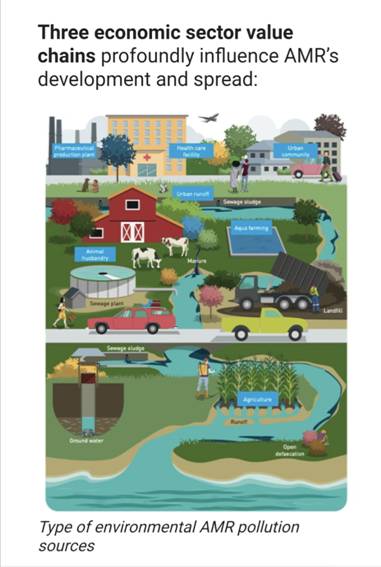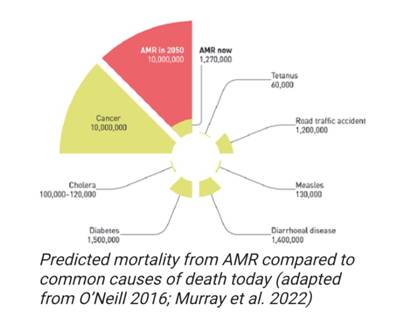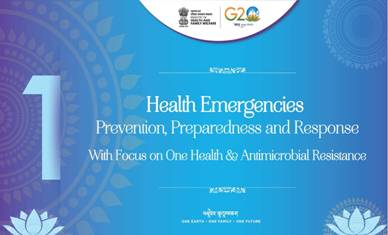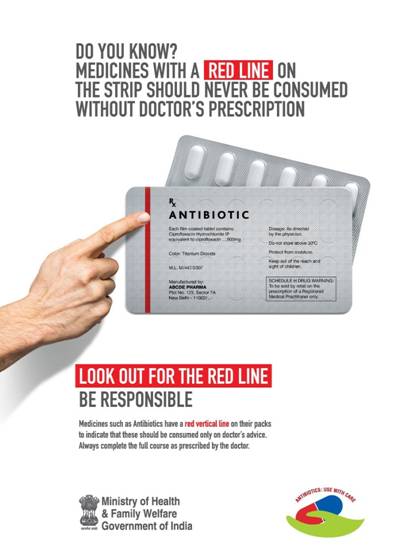The term AMR or Antimicrobial Resistance is fast gaining traction in media reports, scientific research and policymaking. Let us understand what is AMR.
Antimicrobials, including antibiotics, antivirals, antifungals and antiparasitics are often prescribed as they are crucial for preventing and treating infections in humans, animals and plants. Their long use, inappropriate and overuse results in Antimicrobial Resistance which means that these medications are no longer effective in treating the disease. Microorganisms such as bacteria, viruses, fungi and parasites undergo genetic changes over time, thereby rendering them resistant to previously effective medicines. Furthermore, bacteria existing in water, soil and air can also become resistant following contact with resistant microorganisms. This resistance makes infections harder to treat, increases the risk of disease spread and poses severe health risks leading to prolonged, expensive, difficult-to-treat conditions and even death sometimes. The misuse of antimicrobials in human and agricultural settings, the uncontrolled release of antimicrobials into the environment, poor antimicrobial waste management and lack of awareness among stakeholders, high degree of misperceptions, misinformation and misunderstandings often contribute to heightening the problem. Additionally, lack of development of new and effective antibiotics along with limited access to quality antimicrobials aggravate the situation.
United Nations Environment Programme (UNEP) notes that AMR’s development and spread are profoundly influenced by three economic sector value chains- namely, pharmaceuticals and other chemicals manufacturing; agriculture and food which includes food crops, terrestrial animal production and aquaculture; and healthcare delivery in hospitals, medical facilities, community healthcare facilities and in pharmacies where many of chemicals and disinfectants are used.

(Source- UNEP website- https://www.unep.org/explore-topics/chemicals-waste/what-we-do/emerging-issues/ antimicrobial -resistance-global-threat)
Growing global Antimicrobial Resistance (AMR):
AMR is fast emerging as a grave global public health concern. The World Health Organization (WHO) has identified AMR as one of the top 10 global public health threats. A Centers for Disease Control and Prevention (CDC) study of 2019 has revealed that an estimated 3 million infections in America were caused by high priority antimicrobial-resistant pathogens[A11] . World Health Organization (WHO) in its 2016 Global Tuberculosis Report has listed Myanmar, Indonesia, Thailand, Philippines and Vietnam among 27 countries with the highest burden of multidrug resistant tuberculosis globally[A12] . Also, Western Cambodia, bordering Thailand, has been an epicentre of antimalarial resistance since 1950s.

Annually, nearly 700,000 people worldwide die due to AMR-related causes[1].
As per recent estimates, 1.27 million deaths were directly attributed to drug-resistant infections globally in 2019. This figure could escalate to 10 million annual deaths, by 2050. In 2019, the deaths of 25,000 patients in high-income countries of Europe[A13] were found to be from AMR, as per the European Centre for Disease Prevention and Control (ECDC).
As a result of growing cases of AMR, difficulty to treat infections and diseases will severely compound human suffering globally. This will also add to the spending on healthcare as people seek advanced and effective healthcare. With loss of health and wellbeing, productivity is likely to take a noticeable hit thereby adversely impacting individual, national and global financial health and economies. A 2013 study by CDC in the US estimated the cost of AMR was as much as $55 billion per year overall, accounting for $20 billion in excess for direct healthcare costs. While the society costs for lost productivity was estimated to be as high as $35 billion a year.[A14]
A general deficiency in public awareness regarding the ill effects of misuse of antibiotics has boosted large scale spread of AMR across continents. It has been however argued that AMR will disproportionately impact low-income countries and lower-middle-income countries, partly due to the higher burden of communicable diseases in these countries, and more poverty and unhygienic conditions. Some experts have also pointed to lack of regulations, easier availability and over the counter sale of antibiotics for faster spread of AMR in LMICs. A World Bank study predicts that around 24 million people will be forced into extreme poverty by 2030 in low-income countries, and one in six could die due to AMR-related infections[A15] .
WHO notes that “the world is heading towards a post-antibiotic era in which common infections could once again kill[A16] ”. Being cognisant of this growing global public health threat, in 2015, WHO unanimously approved the Global Action Plan (GAP) on AMR urging member states to develop national action plans (NAPs) for actions to be taken within 5–10 years to combat AMR. The goal of GAP-AMR is “to ensure, for as long as possible, continuity of successful treatment and prevention of infectious diseases with effective and safe medicines that are quality-assured, used in a responsible way, and accessible to all who need them”. The GAP emphasizes importance of collaboration between human health, animal health, and environmental sectors to effectively combat AMR.
Food and Agriculture Organisation of the UN (FAO) has also recognised the timely importance of addressing AMR issues through a multisectoral and coordinated ‘One Health’ approach in the context of 2030 SDG (sustainable development goals) agenda. It has issued the FAO Action Plan on Antimicrobial Resistance, 2021-2025 building on the first action plan that covered 2016-20. The focus to effectively prevent and reduce the prevalence of AMR is on strengthening surveillance and research, enhancing stakeholder awareness, enabling good practices, promoting responsible use of antibiotics, and strengthening governance and sustainably allocating resources. “Preventive action will provide an economic benefit, especially when compared to the considerable percent of GDP expected to be lost if AMR is permitted to develop into a global emergency through the widespread failure of medicines”, FAO has pointed out[A17] .
One Health Approach
To address the multifaceted issue of AMR, a “One Health” approach involving multiple sectors is being propounded as an effective framework. The term "One Health" originated during the emergence of severe acute respiratory syndrome (SARS) in 2003-2004, underscoring the interconnectedness between human and animal health and the threats that diseases pose to food supplies and global economies. This concept acknowledges that the health of humans, animals and the environment are integrally intertwined and it encourages all sectors connected to health to be aware of how they contribute to the spread of antimicrobial resistance and in turn, act responsibly. ‘One Health’ represents a collaborative endeavour involving government agencies, academia, and the private sector to address these challenges and provide sustainable solutions through an integrated approach to healthcare.
Several countries and many international agencies have employed the One Health approach while designing their action plans to tackle AMR. The proposed action points include infection control, sanitation, surveillance, improvements in antimicrobial use, strengthened regulation, targeted policies etc. Only some countries have developed action plans to tackle AMR, highlighting the need for a unified approach.
Raising public awareness has been identified as crucial action point for expediting action against AMR. Governments and healthcare institutions must prioritize educational campaigns highlighting the consequences of AMR and advocate for responsible antibiotic usage.
G20 and AMR
AMR has been at the forefront of global discussions. The G20 countries acknowledged the urgency of addressing AMR at the 2017 summit in Hamburg, Germany. The need for international collaborations was emphasized as a part of the key actions to combat AMR. With India at the helm of G20 Presidency this year, it presents a crucial opportunity to advance the One Health agenda as a top priority.

AMR occupies a leading position as part of Priority No. 1 of the Health Track of G20 India, which highlights “prevention, preparedness and response to health emergencies with focus on One Health & Antimicrobial Resistance”. This has been one of the prime areas of detailed discussions at the three meetings of the Health Working Group (HWG) of G20 at Thiruvananthapuram, Kerala, Goa and Hyderabad, Telangana and the Health Ministers’ Meeting at Gandhinagar, Gujarat during this year.
India's stance on antimicrobial resistance (AMR):
Prime Minister Shri Narendra Modi has pledged India’s support in the fight against AMR. “India recognizes anti-microbial resistance as one of the major global threats to public health. We are committed to prevent, contain and combat anti-microbial resistance”, he stated in 2016.
Union Health Minister Dr Mansukh Mandaviya has asserted India’s focus on effectively addressing the challenged posed by AMR. Highlighting India’s G20 Presidency philosophy of “One Earth, One Family, One Future”, he pledged support to global efforts in this direction at the 76th World Health Assembly held at Geneva, in May,2023.
At the Third Global High-Level Ministerial Conference on Antimicrobial Resistance at Muscat, Oman in Nov 2022, Union Minister of State for Health & Family Welfare Dr. Bharati Pravin Pawar reiterated that “Government of India has identified Anti-Microbial Resistance (AMR) as a key priority in its National Health Policy, 2017”.
The key aspects highlighted by National Health Policy 2017 include speedy standardization of guidelines regarding antibiotic use; limited use of antibiotics as over-the-counter medications; banning or restricting use of antibiotics as growth promoters in animal livestock; and pharmacovigilance including prescription audits inclusive of antibiotic usage in the hospital and among people. Dr Pawar elaborated that India’s National Action Plan for containment of AMR (NAP-AMR) which was released in April 2017 focuses on an integrated One Health approach and involves coordination among various sectors at the state, national and international level.
India was one of the first few countries to develop a comprehensive National Action Plan 2017-21 in alignment with the Global Action Plan on AMR (GAP-AMR) with a well defined governance framework to ensure effective implementation. The six key aspects of the NAP focus on surveillance, awareness, reducing incidence of infection, optimizing antibiotic use, promoting research and development, and building India's leadership. The Action Plan envisages leveraging strengths of National Centre for Disease Control (NCDC) and Indian Council Medical Research (ICMR) to coordinate AMR surveillance lab networks, monitor antimicrobial consumption in health facilities, strengthen infection prevention and control, and promote antimicrobial stewardship to optimize use of antimicrobials. Food Safety Standards Authority of India (FSSAI) will play a lead role in monitoring food safety, whereas the Indian Network for Fisheries and Animal Antimicrobial Resistance (INFAAR) will monitor AMR in the animal sector. For effective implementation, state governments are encouraged to draw up their respective action plans depending on state-specific issues. Several States have drawn complementing action plans.
India's National Action Plan on AMR has made notable progress. Union Health Ministry has taken several initiatives to restrict over-the-counter availability and inappropriate consumption of antimicrobials, promote infection prevention and control practices in hospitals (National Guidelines for Infection Prevention and Control in healthcare facilities were issued in January 2020), and regulate antimicrobial waste in healthcare facilities, pharmaceutical industries, agriculture, livestock, and food production sectors. Work on developing NAP 2.0 has begun with inputs being collected from different stakeholders. India has also launched two significant initiatives to strengthen health infrastructure, namely the Pradhan Mantri Ayushman Bharat Health Infrastructure Mission and the 15th Finance Commission health grants which aim to strengthen public health infrastructure. Rs. 1482.50 Crores has been allocated (for period of 5 years from 2021-22 to 2025-26) to establish 730 integrated public health laboratories in all districts and 7,225 block public health units.
An overview of the key initiatives undertaken by the Indian government to contain antimicrobial resistance is:
1. Red Line Campaign on Antibiotics: In 2016, Union Ministry of Health and Family Welfare launched the "Red Line Campaign on Antibiotics". The campaign aimed to restrict the over-the-counter availability of antibiotics and raise awareness about the dangers of taking antibiotics without proper prescriptions. As part of this campaign, the antimicrobials not to be taken without doctor’s prescription are marked with a red line, to highlight the risks associated with their misuse.

2. National Treatment Guidelines: Guidelines for antimicrobial use in infectious diseases were released in Feb 2016 and widely disseminated to serve as a guide for the health care facilities to formulate their own guidelines. These are being updated based on current AMR trends in the country.
3. National Guidelines for Infection Prevention and Control: In 2020, MOHFW published National Guidelines for Infection Prevention and Control (IPC) in Healthcare Facilities in coordination with the World Health Organization. They focus on combating AMR through infection prevention and control practices. Based on these guidelines, training of trainers for IPC in healthcare facilities have been conducted in 31 states/UT, which is being further cascaded in other states.
4. Regulations and Policies on Antimicrobial Waste in Pharmaceutical Industries: The Environment Protection Rules, 1986 set standards for industrial waste, including the pharmaceutical industry. Pharmaceutical companies are required to comply with effluent standards to prevent the discharge of untreated contaminated water into the environment. In January 2020, Government notified a draft regulation, Environment (Protection) Amendment Rules 2020 to prevent the release of antibiotics from pharmaceutical industries into the environment.
5. Regulations and Policies on AMR in Agriculture, Livestock, and Food: The Food Safety and Standards (contaminants, toxins, and residues) Amendment Regulations, 2011 has established tolerance limits for antibiotics and veterinary drugs in food products. Additionally, specific antibiotics are banned in fish and livestock industries. Food Safety and Standards Authority of India (FSSAI), under MoHFW has placed extensive bans on antibiotics and pharmacologically active substances in fisheries.
6. AMR Surveillance networks: At the national level, two AMR surveillance networks namely National Antimicrobial Resistance. Surveillance Network (NARS-Net India) (coordinated by NCDC) and Antimicrobial Resistance Surveillance and Research Network (AMRSN), coordinated by ICMR, were initiated in 2013. Under NARS-Net, the focus is to strengthen laboratory capacity of state government medical colleges in a phased manner. It currently includes 40 state medical colleges in 31 states/UTs. The network is being expanded in a phased manner across all states/UTs. AMRSN focuses on surveillance and research and includes 30 large hospital laboratories including central & state government institutes and private Institutions. State level AMR surveillance networks have been established in 3 states and are being expanded to other states.
7. Antimicrobial Stewardship Program (ASP): The Indian Council of Medical Research (ICMR) initiated the Antimicrobial Stewardship Program and Infection Control (ASPIC) in 2012. ASPIC aims to restrict inappropriate antibiotic use, optimize treatment outcomes, and minimize adverse events and the emergence of resistance. The program includes the development of treatment and infection control guidelines, engagement with healthcare institution leaders, and training on antimicrobial stewardship.
Involvement of private sector:
Investments in research and development play a vital role in discovering new antimicrobials and alternative treatments for AMR. It will serve well if Governments and private sector investors can allocate additional resources to support scientific research addressing AMR. Collaborative efforts across national boundaries will expedite progress in this field. To comprehensively tackle AMR, active involvement of the private sector, particularly pharmaceutical companies, has found favour. They can contribute by investing in research and development for alternative treatments and promoting responsible antibiotic use through marketing and educational campaigns.
Private sector doctors can contribute to addressing this grave health issue by responsibly prescribing antibiotics, and informing the patients regarding their misuse. Studies have associated higher AMR in regions where private sector is the dominant provider of healthcare services, as they are incentivised through higher out-of-pocket- expenditure to over-prescribe antibiotics without any self regulation[A18] .
Way forward:
As we move ahead with a resolve to contain and prevent AMR, it is important to have a database on various aspects of AMR; factors that create it, that amplify it, its impacts; and solutions. Surveillance is an important tool to create such a repository. It is also crucial for assessing the spread of AMR and its trends, and to monitor the impact of strategies at the local, national and global levels which will help us to build on the existing knowledge on the subject. This will contribute in framing more strategies and policies that are evidence based, with tailor made solutions to regional problems.
Towards this end, the Global Antimicrobial Resistance and Use Surveillance System (GLASS) was created by WHO in 2015. This has played an important role as it has standardised data collection and its analysis and interpretation. GLASS has enabled data sharing within countries and is actively supporting capacity building, while also helping to monitor the status of national surveillance systems.
However, GLASS requires updation to keep up with the evolving nature of AMR. By expanding the scope of data collection, improving data quality, developing advanced analytical tools, and increasing participation from countries, we can enhance our understanding of AMR trends and guide targeted interventions. This will also facilitate the identification of regions with a high prevalence of AMR, guiding the allocation of resources and interventions to address these. Additionally, updating GLASS with regional interventions will provide a comprehensive understanding of the key drivers of AMR, empowering policymakers and researchers to develop evidence-based policies and interventions. Low- and middle-income countries (LMICs) require technical support for capacity building in real-time data collection. This can be supported by the development of an easy to use digital platform to enable countries to collect and collate their data at national and sub-national level from multiple centres.
G20 has already contributed to the WHO and World Bank Pandemic Fund launched during the Indonesia Presidency in November 2022. The Fund has secured more than $1.6 billion in donations, mainly from G20 members, and will strengthen the health emergency preparedness, response, and resilience (HEPR) in several countries of the Global South. This Fund can be utilized in workforce capacity building and maintaining the capacity of laboratories to monitor AMR effectively. With their combined economic power and influence, G20 countries have a crucial role in tackling AMR through a multifaceted ‘One Health’ approach encompassing accelerating the development of new antimicrobials & diagnostics, improving existing treatments & promoting judicious use of antimicrobials, strengthening infection prevention and control, and enhancing surveillance and monitoring. The G20 India Health Ministers’ Meeting at Gandhinagar, Gujarat concluded with the G20 members unanimously committing to tackling AMR comprehensively following the One Health approach through strengthening multi-sectoral governance, coordination; research and development (R&D); infection prevention and control (IPC); water, sanitation and hygiene (WASH); improving awareness of AMR; promoting responsible use of antimicrobials including preserving the existing therapeutics across humans, animals and plant sectors through antimicrobial stewardship.
*****
Author- Dr Manisha Verma, Addl. DG (Media & Communication), Union Health Ministry